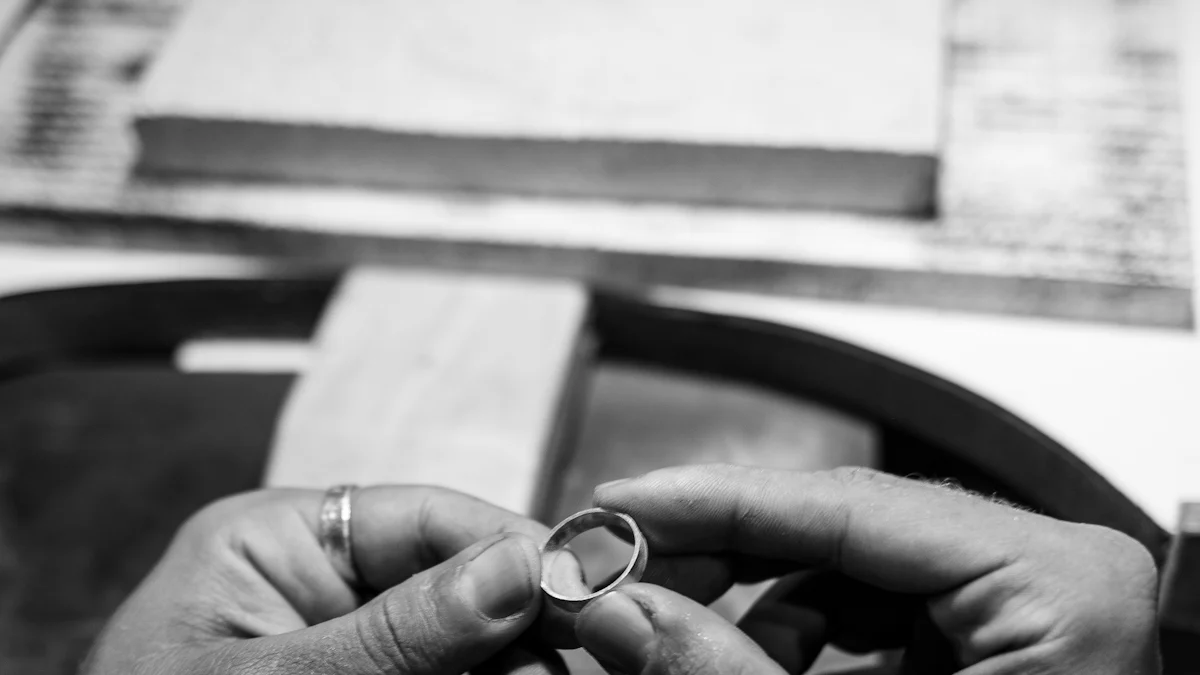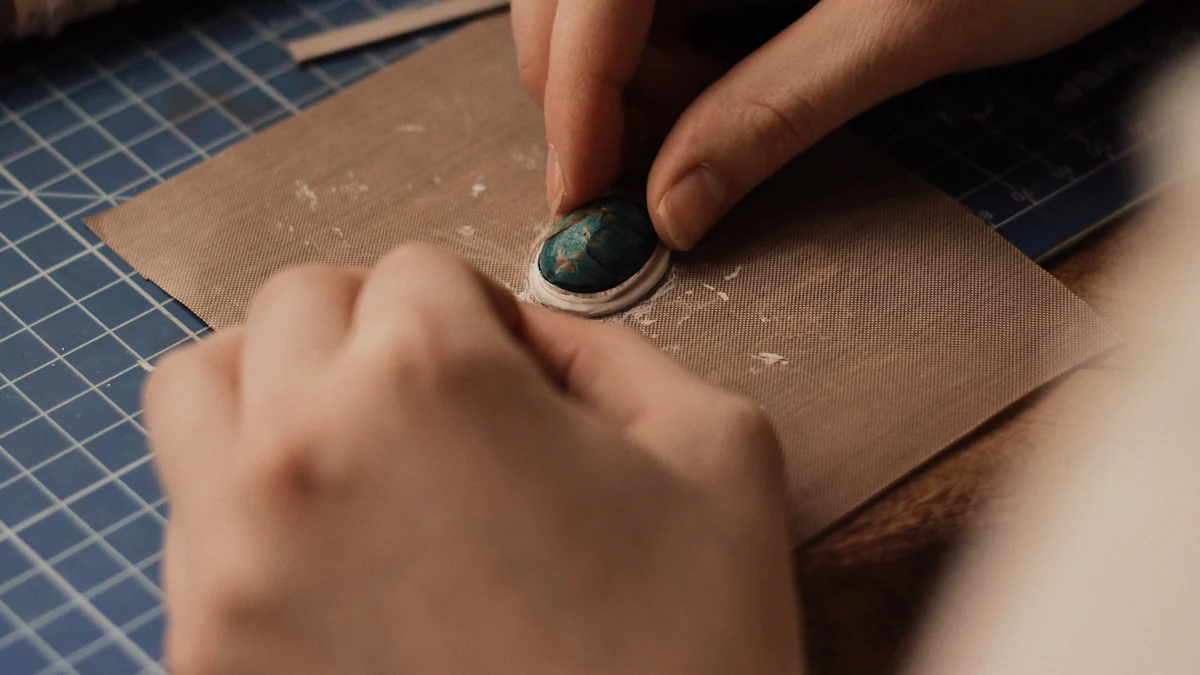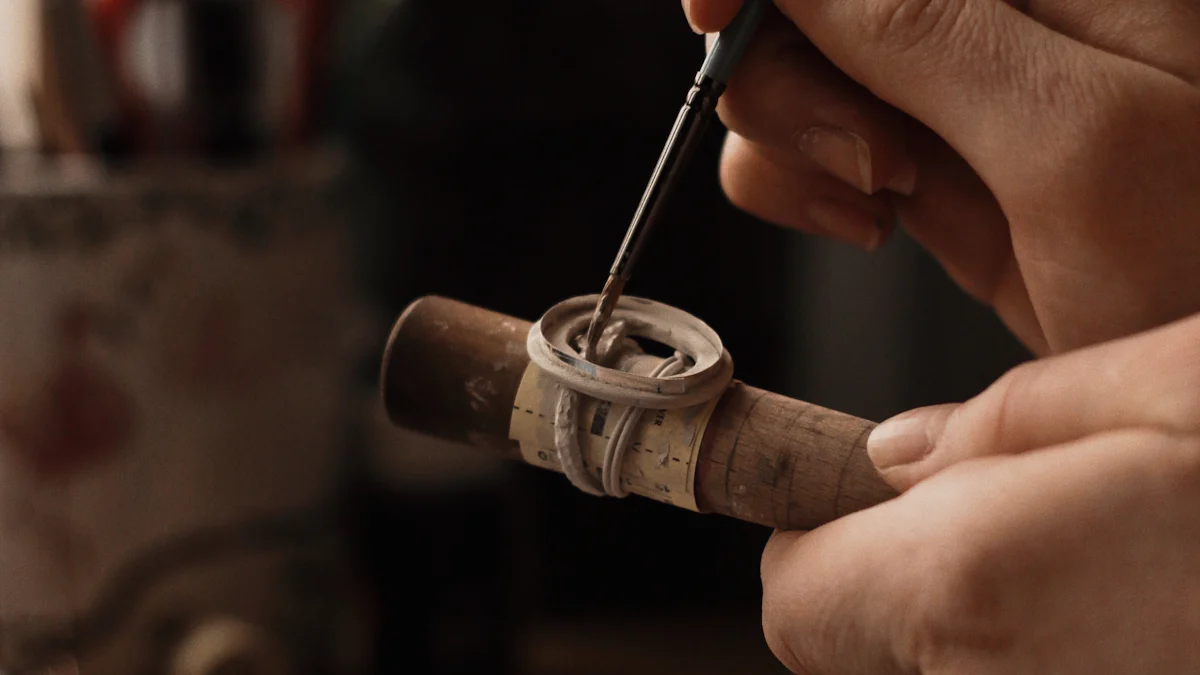The Art of Crafting Bean Cut Diamonds

The bean cut diamond captivates with its distinctive shape and radiant brilliance. Its design reflects a perfect harmony of artistry and precision, showcasing the skill of master artisans. This unique cut enhances light performance, creating a mesmerizing sparkle that draws the eye. Beyond its visual appeal, the bean cut diamond carries deep emotional significance. Its organic form symbolizes growth, love, and individuality, making it a meaningful choice for those seeking something truly special. Every facet tells a story, blending craftsmanship with heartfelt expression.
Key Takeaways
- Bean cut diamonds are unique due to their organic shape, symbolizing growth and individuality, making them a meaningful choice for personal expression.
- The design and cutting of bean cut diamonds require exceptional skill, blending advanced technology with traditional craftsmanship to enhance light performance.
- When selecting a bean cut diamond, prioritize cut quality, symmetry, and clarity to ensure maximum brilliance and sparkle.
- Choose a setting that complements the diamond's organic shape; minimalist designs can highlight its curves, while intricate settings add elegance.
- Regular cleaning and proper care are essential to maintain the diamond's brilliance; use a mild soap solution and store it safely to prevent damage.
- Bean cut diamonds offer a refreshing alternative to traditional cuts, appealing to those who value creativity and artistry in their jewelry.
- Investing in a high-quality bean cut diamond not only ensures lasting beauty but also connects you to the exceptional craftsmanship behind its creation.
The Craftsmanship Behind Bean Cut Diamonds

Designing the Bean Cut Diamond
Designing a bean cut diamond begins with a vision. You start by imagining how the unique bean shape will interact with light. This step involves planning the arrangement and proportions of the diamond’s facets. Each facet plays a role in capturing and reflecting light, creating the brilliance that makes this cut so captivating.
Experts emphasize that the design process is not just about aesthetics. It also considers the diamond’s natural properties, such as its clarity and structure. As one expert explains, “The overall design of the diamond, including the arrangement and proportions of its facets, determines how the stone interacts with light.” This meticulous planning ensures that the final piece achieves both beauty and functionality.
Precision Cutting Techniques
Cutting a bean cut diamond requires exceptional skill and precision. You need to use advanced tools to shape the diamond into its distinctive bean form. Artisans carefully remove excess material while preserving the stone’s integrity. Each cut must align perfectly with the design plan to enhance the diamond’s light performance.
Modern technology plays a significant role in this process. Laser cutting tools allow artisans to achieve unparalleled accuracy. However, the human touch remains essential. Skilled cutters rely on their expertise to make adjustments and bring out the diamond’s full potential. This combination of technology and craftsmanship ensures that every bean cut diamond stands out as a masterpiece.
Polishing and Finishing for Maximum Brilliance
Polishing transforms a rough-cut diamond into a sparkling gem. You’ll notice that this step focuses on refining the surface to eliminate imperfections. Artisans use specialized polishing wheels to smooth each facet, ensuring it reflects light flawlessly.
The finishing process enhances the diamond’s brilliance and gives it a mirror-like shine. This step requires patience and attention to detail. Even the smallest flaw can affect the diamond’s overall appearance. By the end of this process, the bean cut diamond achieves its signature radiance, ready to captivate anyone who sees it.
The Aesthetic and Symbolic Significance of Bean Cut Diamonds

The Organic Shape and Its Connection to Nature
The bean cut diamond stands out with its organic, flowing shape. Its design mirrors the natural curves found in leaves, seeds, and other elements of the natural world. This connection to nature gives the diamond a unique charm that appeals to those who value individuality and harmony. Unlike traditional geometric cuts, the bean cut embraces asymmetry, creating a softer and more fluid appearance.
Throughout history, jewelry has often drawn inspiration from nature. For example, during the Art Deco period, designs emphasized symmetry and geometry, but they also incorporated natural motifs like flowers and vines. The bean cut diamond continues this tradition by blending modern craftsmanship with timeless organic beauty. Its shape not only enhances its visual appeal but also symbolizes growth and renewal, making it a meaningful choice for many.
Emotional Value and Artistic Expression
The bean cut diamond carries deep emotional significance. Its unique form allows you to express your individuality and personal style. While traditional cuts like round or princess shapes are popular, the bean cut offers something different. It reflects creativity and a desire to stand out, making it perfect for those who appreciate artistry in their jewelry.
Selecting a diamond shape is more than just a design choice. It defines how the diamond interacts with light and complements the overall jewelry style. The bean cut diamond, with its distinctive curves, creates a softer sparkle that feels intimate and warm. This makes it an ideal choice for engagement rings or meaningful gifts. Its artistic design also allows jewelers to craft settings that enhance its beauty, further emphasizing its emotional and symbolic value.
"A diamond’s shape defines its personality and how it connects with the wearer," as experts often say. The bean cut diamond embodies this idea by offering a blend of elegance and individuality. Its design speaks to those who value both beauty and meaning in their jewelry.
Tips for Selecting the Perfect Bean Cut Diamond
Evaluating the Cut for Symmetry and Brilliance
When selecting a bean cut diamond, you should prioritize its cut quality. The cut determines how well the diamond interacts with light, directly influencing its sparkle and brilliance. A well-cut diamond will reflect light beautifully, creating a dazzling effect. On the other hand, a poorly cut diamond may appear dull or lifeless, regardless of its clarity or color.
To evaluate the cut, examine the symmetry of the facets. Each facet should align perfectly to ensure optimal light reflection. Look for brightness, fire, and scintillation. Brightness refers to the white light reflected from the diamond, fire is the dispersion of light into rainbow colors, and scintillation measures the sparkle when the diamond moves. These factors work together to create the captivating brilliance that makes a bean cut diamond stand out.
Understanding Clarity and Color in Bean Cut Diamonds
Clarity and color play a significant role in the overall appearance of a bean cut diamond. Clarity refers to the presence of internal or external imperfections, known as inclusions and blemishes. While no diamond is entirely flawless, you should aim for a clarity grade that ensures imperfections are not visible to the naked eye. This enhances the diamond's beauty without compromising its natural character.
Color grading evaluates the presence of any tint within the diamond. The scale ranges from colorless to noticeable yellow or brown hues. For a bean cut diamond, a near-colorless or colorless grade often works best, as it allows the unique shape and brilliance to shine without distraction. Always view the diamond under natural light to assess its true color and clarity.
Choosing the Ideal Setting for Your Diamond
The setting you choose can significantly impact the overall look and feel of your bean cut diamond. A well-designed setting not only secures the diamond but also enhances its beauty. Popular options include prong settings, which elevate the diamond to maximize light exposure, and bezel settings, which provide a sleek and modern appearance while offering extra protection.
Consider how the setting complements the organic shape of the bean cut diamond. A minimalist design can highlight the diamond's unique curves, while intricate settings can add a touch of elegance. Additionally, think about the metal type. White gold or platinum can enhance the diamond's brilliance, while yellow or rose gold can create a warm and romantic look. Choose a setting that aligns with your personal style and the diamond's aesthetic.
Why Bean Cut Diamonds Are a Timeless Choice
The Unique Appeal of Non-Traditional Cuts
Non-traditional diamond cuts, like the bean cut diamond, offer a refreshing alternative to conventional shapes. These unique designs break away from the symmetry and uniformity of traditional cuts, such as the round or princess cut. Instead, they embrace individuality and creativity. The bean cut diamond, with its organic and flowing shape, stands out as a symbol of originality. Its design captures attention and reflects a sense of personal style that resonates with those who seek something different.
Unlike traditional cuts that focus on uniform sparkle, non-traditional cuts often highlight specific features. For example, the Asscher cut emphasizes long, clean facets that create a staircase-like effect, offering flashes of light rather than an all-over sparkle. Similarly, the bean cut diamond enhances its natural curves to create a softer, more intimate brilliance. This distinct approach to light performance makes it a captivating choice for anyone who values artistry in their jewelry.
Choosing a non-traditional cut like the bean cut diamond allows you to celebrate your individuality. It offers a chance to own a piece of jewelry that feels personal and meaningful. Whether for an engagement ring or a statement piece, this cut ensures your diamond will always stand out.
A Testament to Exceptional Craftsmanship
The bean cut diamond represents the pinnacle of craftsmanship. Its unique shape requires a deep understanding of diamond cutting techniques and an unwavering commitment to precision. Artisans must carefully balance the diamond’s natural properties with the desired design, ensuring every facet enhances its beauty and brilliance. This level of expertise transforms each bean cut diamond into a masterpiece.
Creating this cut involves a blend of traditional methods and modern technology. Skilled artisans use advanced tools, such as laser cutters, to achieve the intricate curves of the bean shape. However, the human touch remains essential. Every decision, from the angle of a facet to the final polish, reflects the artisan’s dedication to perfection. This meticulous process ensures that each diamond not only looks stunning but also performs brilliantly under light.
Owning a bean cut diamond means owning a piece of art. It showcases the skill and passion of the craftspeople who brought it to life. This connection to exceptional craftsmanship adds to its timeless appeal, making it a treasure you can cherish for generations.
Caring for Your Bean Cut Diamond
Cleaning and Maintenance Best Practices
Keeping your bean cut diamond clean ensures it maintains its brilliance and sparkle. Dirt, oil, and residue can accumulate on the surface over time, dulling its shine. Regular cleaning helps preserve its beauty and enhances its light performance.
To clean your diamond at home, follow these steps:
- Prepare a Cleaning Solution: Mix warm water with a few drops of mild dish soap in a small bowl. Avoid harsh chemicals or abrasive cleaners, as they can damage the diamond or its setting.
- Soak the Diamond: Place your diamond jewelry in the solution for 15–20 minutes. This loosens dirt and grime from the surface and hard-to-reach areas.
- Gently Brush the Diamond: Use a soft-bristled toothbrush to clean the diamond. Focus on the facets and the area around the setting. Be gentle to avoid scratching the metal or loosening the stone.
- Rinse Thoroughly: Rinse the diamond under lukewarm running water. Ensure no soap residue remains, as it can leave a film on the surface.
- Dry with Care: Pat the diamond dry with a lint-free cloth. Avoid using paper towels, as they can leave fibers behind.
For professional cleaning, visit a jeweler every six months. Jewelers use ultrasonic cleaners and steamers to remove stubborn dirt and restore the diamond's brilliance. This also provides an opportunity to inspect the setting for any signs of wear or damage.
Protecting Your Diamond for Longevity
Proper care extends the life of your bean cut diamond and keeps it looking stunning for years. Diamonds are durable, but they still require protection from potential damage.
Here are some tips to safeguard your diamond:
- Store It Safely: Use a soft-lined jewelry box or a fabric pouch to store your diamond. Keep it separate from other jewelry to prevent scratches or chips.
- Remove It During Activities: Take off your diamond jewelry before engaging in activities like gardening, exercising, or cleaning. These activities expose the diamond to dirt, chemicals, and impact, which can harm its appearance or setting.
- Avoid Harsh Chemicals: Chemicals in household cleaners, perfumes, and hairsprays can damage the diamond or its metal setting. Apply these products before putting on your jewelry.
- Inspect the Setting Regularly: Check the prongs and other parts of the setting for signs of wear or looseness. A secure setting prevents the diamond from falling out. If you notice any issues, consult a jeweler immediately.
- Insure Your Diamond: Consider insuring your diamond against loss, theft, or damage. This provides peace of mind and financial protection for your valuable piece.
By following these practices, you ensure your bean cut diamond remains a cherished treasure. Proper care not only preserves its beauty but also honors the craftsmanship and artistry behind its creation.
Bean cut diamonds embody the pinnacle of craftsmanship, blending artistry with precision to create a truly unique gem. Their organic shape and radiant brilliance make them a timeless choice, appealing to those who value individuality and creativity. These diamonds symbolize more than beauty; they represent personal expression and exceptional skill. By appreciating the dedication behind each piece, you connect with the artistry that transforms raw stones into dazzling treasures. Choosing a bean cut diamond means celebrating both its aesthetic value and the mastery that brings it to life.
FAQ
What makes the bean cut diamond unique?
The bean cut diamond stands out due to its organic, asymmetrical shape. Unlike traditional cuts, it mirrors natural forms like seeds or leaves, giving it a distinctive charm. This design enhances individuality and creates a softer, more intimate sparkle.
How does the cut of a diamond affect its brilliance?
A diamond’s cut determines how its facets interact with light. The quality of the cut influences brightness, fire, and scintillation. A well-cut diamond reflects light beautifully, creating a dazzling effect, while a poorly cut one may appear dull.
Are bean cut diamonds suitable for engagement rings?
Yes, bean cut diamonds make excellent choices for engagement rings. Their unique shape symbolizes growth and individuality, adding emotional value. They also pair well with various settings, allowing you to create a ring that reflects personal style.
What should you consider when choosing a bean cut diamond?
When selecting a bean cut diamond, focus on the cut quality, symmetry, and brilliance. Evaluate clarity to ensure imperfections are minimal and choose a color grade that complements the diamond’s shape. The setting should also enhance its organic design.
How do bean cut diamonds compare to traditional cuts?
Bean cut diamonds differ from traditional cuts like round or princess shapes. They embrace asymmetry and natural curves, offering a unique aesthetic. While traditional cuts prioritize uniform sparkle, bean cuts create a softer brilliance that feels more personal.
What factors influence the price of a bean cut diamond?
The price depends on several factors, including carat weight, cut quality, clarity, and color. The craftsmanship involved in creating the unique bean shape also adds to its value. Investing in a high-quality bean cut diamond ensures lasting beauty and brilliance.
Can you customize jewelry with a bean cut diamond?
Yes, bean cut diamonds are ideal for custom-made jewelry. Their unique shape allows for creative settings that highlight their beauty. When designing custom pieces, consider factors like the diamond’s cut, clarity, and the metal type for the setting.
How do you care for a bean cut diamond?
To maintain its brilliance, clean your bean cut diamond regularly using a mild soap solution and a soft brush. Store it separately to avoid scratches and inspect the setting periodically. Professional cleaning every six months helps preserve its sparkle.
What settings work best for bean cut diamonds?
Prong settings elevate the diamond, maximizing light exposure, while bezel settings offer a sleek, modern look with added protection. Minimalist designs highlight the diamond’s curves, while intricate settings add elegance. Choose a setting that complements your style.
Why are bean cut diamonds considered timeless?
Bean cut diamonds combine artistry and precision, making them timeless. Their unique shape and radiant brilliance appeal to those who value individuality. They symbolize personal expression and exceptional craftsmanship, ensuring they remain cherished for generations.
See Also
A Guide To Diamond Cuts For Your Engagement Ring
Discovering The Charm Of Diamond Dust Jewelry
A Look Into Various Styles Of Diamond Wedding Rings
Step-By-Step Instructions For Making An Engagement Ring Cake

